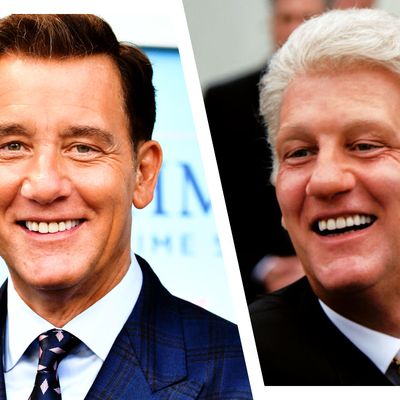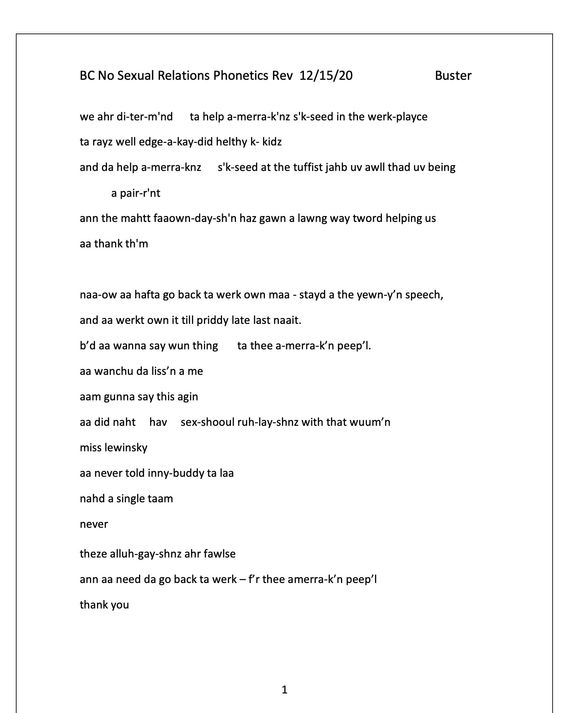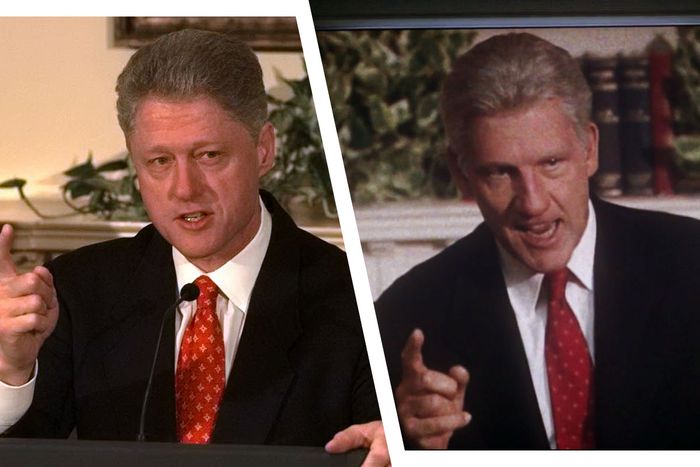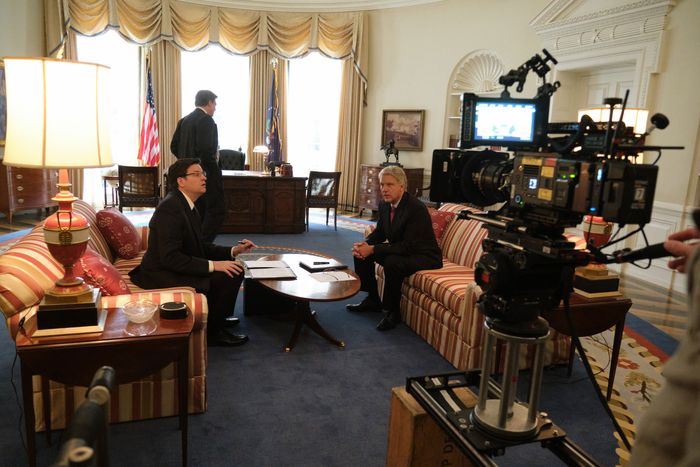
When Clive Owen learned that Ryan Murphy was thinking about casting him as Bill Clinton in the Impeachment season of American Crime Story, he had one thought: Of everybody, why would he do that?
It’s a fair question. The British actor doesn’t look much like the former somewhat doughy American president. But for Murphy and executive producer Brad Simpson, it was all about the eyes.
“Clinton was known for taking up a lot of space in a room and for having a certain type of magnetism, which Clive inherently has. All eyes go to him,” Simpson says. “Clive has something that Clinton also has, which is a lot going on behind these really emotive eyes. Then there’s the basic thing, of course, that Clive is just an incredible actor.”
After spending an hour with the producers and hearing their goals for the show — mostly that it’d focus on the women in Clinton’s orbit, including Monica Lewinsky, Linda Tripp, Paula Jones, and Hillary Clinton — Owen was intrigued. “I started looking at all the footage from that period, reminding myself about the whole thing. The stakes were so high, and it was a story that reverberated around the world,” he says. Despite earlier misgivings, Owen saw the appeal of taking on a role with physical requirements and historical weight unlike anything he’d ever done before. “There’s something sort of attractive about being scared. It pushes you to do things that you would not ordinarily do,” he says. “And the fascination of trying to recreate some of that footage exactly as it was — I couldn’t shake that off.”
As viewers of the show can attest, it’s easy to forget it’s Owen playing Clinton. That’s due to a number of factors: the writing, the actor’s intense preparation, the hair and makeup, and the filming of the show itself. To paraphrase Hillary, it took a village of collaborators to transform Clive into Bill, and Vulture spoke to Owen, Simpson, and five members of Impeachment’s behind-the-scenes team to learn how it all went down.
The Writing
As Madeline Kaplan’s fact-checking of the series proves, Impeachment takes its historical accuracy seriously. To that end, writer Sarah Burgess drew from a number of sources, including the recollections of Lewinsky, who served as a producer on the series. Both Burgess and Simpson say Owen insisted on portraying Clinton as a flawed human.
“Clive really wanted to know that we were going to show all the complexity of Bill Clinton: the good, the bad, and the gray,” Simpson says. “Our objective every season, with every character, is to know what it’s like to walk in their shoes. I said, ‘You’ll get an episode where you really walk in Clinton’s shoes as the world is collapsing around you.’” The episode is the season’s seventh, titled “The Assassination of Monica Lewinsky,” in which Owen’s Clinton sits for an increasingly tense deposition in the Paula Jones sexual harassment case and publicly utters the infamous “I did not have sexual relations with that woman” line after his affair comes to light.
Burgess notes that Owen himself was a diligent fact-checker who always noticed when the scripts deviated from Clinton’s actual words. “I have a memory of Clive in his full Clinton prosthetics chasing me down a hallway of the West Wing set because he was so excited to match Clinton’s actual language, speech pattern, pauses, ums and uhs, and dry mouth to the real video,” she says. “Clive would confer with me a lot, even about slight changes. Sometimes it was the sound of something or the feel: ‘Am I just being flat? Am I being incredibly manipulative here? What is this based on?’ It was delightful.”
“Obviously, because of TV, you’re never going to show everything, but I was very concerned when it was too abbreviated or neat because people searching for things is where the real drama is,” Owen adds. “Ultimately, you try to make it as believable as you can.”
Interestingly, Owen never met with Lewinsky to discuss his portrayal — as Simpson pointed out, they felt it was better that he only see Beanie Feldstein as Monica. “I wasn’t sure what that would do for me, really,” Owen says. “ I knew she was very present in the process and that she talked to Sarah and Ryan a lot. I thought it was better to just concentrate and work, really.”
The Accent
Memorizing Clinton’s words was one thing, but it took much more intensive work to nail the President’s southern accent. Owen enlisted the help of dialect coach Michael Buster to switch from his natural British baritone to the higher-pitched, occasionally raspy Arkansas lilt. They started working together in December 2019, with Owen scheduled to start filming in the spring of 2020; that date was ultimately pushed to February 2021 because of the pandemic.
“With Clinton, the research is done for you already. There’s so much archival footage,” Buster says. “We looked at, of course, the famous speech: ‘I did not have sexual relations with that woman.’ We looked at the deposition because that’s all on video. And we looked at his acceptance speech when he was reelected. Then there were a couple of vignettes online where he was being conversational — more casual, everyday speech.”
Buster began by identifying Clinton’s trademark sounds then transcribed the scripts phonetically. For instance, “I did not have sexual relations with that woman, Miss Lewinsky. I never told anybody to lie” became “aa did naht hav sex-shooul ruh-lay-shnz with that wuum’n, miss Lewinsky. Aa never told inny-buddy ta laa.” Buster would record himself reading the script and reciting similar words in Clinton’s accent, so Owen could listen and repeat them verbatim.
One particular peccadillo Buster and Owen worked through was a higher-pitched rasp that would occasionally appear when Clinton was tense. “There’s a thinness to his voice,” says Buster. “I read that he had acid reflux, so his vocal cords were constantly being burned, but also, he talks so much — just vocal fatigue. So we listened to that and found the placement of where it lives. Even though he’s a big man, there was not a lot of body resonance in his voice. It sits right up in his neck and back of his throat, so we incorporated all those elements.”
The pair worked together in person, on set and off, and over Zoom, and Owen would listen to recordings of both Buster and Clinton while sitting in makeup every day. Eventually, the practice paid off, and Clinton’s voice became muscle memory for the star, allowing him the headspace to focus on his expressions and movements. And even though he’s not a method actor, Owen always stuck with the accent while he was on set, lest he slip up and let his natural Englishness come through.
“I learned a while ago doing accents, I’m not very good at switching on and off,” he says. “I used to find it very pretentious when I saw actors staying in the accent all the time. Then there came a point where I realized, actually, it’s really important for me to do that because rhythmically and sensibility-wise, you keep in the right place.”
The Hair and Makeup
When it came to physically matching Clinton’s appearance, Owen was initially in favor of a drastic transformation, while Murphy wanted as few prosthetics as possible. The compromise, according to prosthetics makeup designer Justin Raleigh, was to start with the most extreme configuration and pare it back to a version that resembled Clinton but didn’t erase Owen.
Raleigh began by taking a life-cast scan of Owen. Using Photoshop, he overlaid that image with one of Clinton to identify what needed to be changed. “Obviously we can’t take anything away, so we’re limited to what we can augment,” says Raleigh. “With Clinton, the big elements were really the forehead — Clive has very big, full, bushy eyebrows, where Clinton had very, very thin brows — and then, obviously, Bill Clinton has a very distinct bulbous nose shape as well.”
Using a model of Owen’s head, Raleigh tested prosthetic designs with clay. He landed on two separate applications — a nose piece adding height to the bridge of the actor’s nose to make it appear thinner and a full forehead piece for the eyebrows — and manufactured them using silicone ranging from ¼ to 1/32 of an inch in thickness. The eyebrows were constructed over the course of three and a half hours, with each hair (sourced from humans, Angora rabbits, and bears) individually punched into the silicone. Then, Raleigh would slick down and paint over Owen’s bushy eyebrows and glue the prosthesis on with silicone adhesive. Because the pieces were so thin and fragile, they could only be used once, meaning that each day of filming required a new piece plus backups.
The reusable portions of the whole getup were the wigs, which were overseen by hairstylist Suzy Mazzarese-Allison and built by designer Stacey Butterworth. To measure for the hairpiece, they wrapped Owen’s head in plastic and drew on a hairline to resemble Clinton’s. They then picked out six colors — shades of white, silver, and brown — of actual human hairs that would be combined for the three wigs that represented different time periods in Clinton’s life: a darker one for flashbacks and two lighter ones — one slightly fuzzy and one more neatly trimmed.
“We didn’t want to make his hair look too white because he has a totally different skin tone than Clinton,” says Mazzarese-Allison. “We found a place that resembled Clinton, but you still kind of know it’s Clive. We wanted to make it not so fake.”
To put the wig on, Mazzarese-Allison would slick Owen’s hair down with a strong gel, airbrush white makeup around his hairline, and attach the lace-based wig with adhesive and toupee clips. At the end of the shooting day, she’d gently remove and clean it with alcohol (she shampooed and conditioned it every two days) then style it again in the morning with sprays of Evian water, mousse, and a blow-dryer.
Between the prosthetics and wig application, the process took an hour and 45 minutes each day, longer than Owen had done on any other project. The one area where he didn’t need any prosthetic help was mimicking Clinton’s gut.
“I got the belly down, don’t worry about that,” he says, laughing. “I just ate what I wanted.”
The Camera
With the lines set, the accent dialed in, and the prosthetics and hairs glued on, all that was left for Owen to do was act. But the performance could only fully come together behind the camera through the efforts of the directors and cinematographer Simon Dennis. It was decided early on that they’d take cues from the Washington-intrigue work of director Alan J. Pakula and cinematographer Gordon Willis for a throwback effect.
“Ryan came to the table with two massive references: All the President’s Men and The Parallax View. He wanted that sort of shadowy, ’70s conspiracy-movie feel, which got me really excited because Gordon Willis is my all-time hero,” says Dennis. “With Clinton, I always saw him as being almost ambiguously backlit, more in shadow — iconic but at the same time mysterious, like the smoking man in the car park. All you see are his eyes and the backlit smoke. I was taking those tricks before we start to unveil Bill in a way that was more honorable to his own problems and dilemmas.”
The team used several subtle maneuvers to add a sense of unease. Some overhead shots of the West Wing spin counterclockwise, an effect meant to disorient viewers. In many other scenes, the camera angles emphasize the male characters physically imposing over the women, giving everyday interactions a feeling of menace. In the deposition scene, close-ups are used to emphasize Clinton’s growing realization that he’s caught in a lie.
“When we’re shooting the questions, that would be off eyeline, but when we’re on Bill, I had it uncomfortably close,” says Dennis. “Then we would slowly, over the course of the edit, work our way into him. Every time you cut back to Bill as the questions go on, the camera gets closer and closer. And as we moved in, we were using wider lenses, so it feels a bit warped. That’s a very simple technique.”
Dennis was also tasked with re-creating the camera angles of archival interviews and news footage so Impeachment would look identical. Despite the inherent challenges, these scenes were particularly fun for Owen to film.
“There’s something quite unusually satisfying for an actor about knowing clearly what the objective is,” Owen says. “Weirdly, it’s a bit like doing stunts — it’s a very definite thing. It’s not open to your interpretation.”




